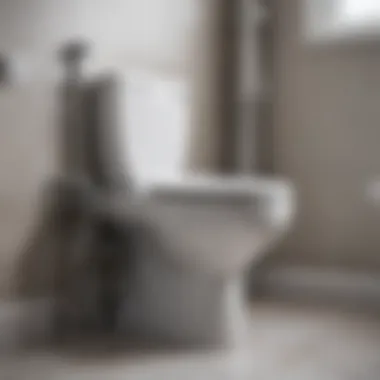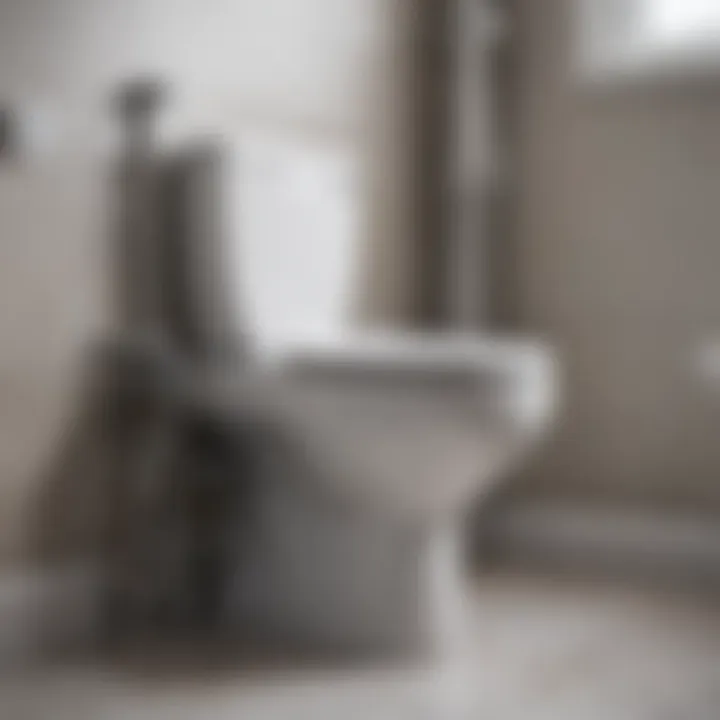Understanding Toilet Blockages: Causes and Solutions


Intro
Blockages in toilets are a common issue faced by homeowners. Understanding the mechanisms that lead to clogs can help prevent them. This understanding also provides insight into the necessary maintenance required to keep toilets functioning properly. Without regular care, minor issues may escalate into major problems that require costly repairs.
Importance of Proper Maintenance
Maintaining a toilet goes beyond just keeping it clean. It involves being aware of what goes down the drain. Items that should not enter a toilet include:
- Sanitary products: These can cause significant blockages.
- Wipes: Even those labeled as "flushable" can lead to problems.
- Excessive toilet paper: Using large amounts can overwhelm the plumbing.
By being mindful of these items, homeowners can significantly reduce the risk of clogs.
Awareness of Plumbing Mechanisms
Many homeowners may not be aware of how toilets function. Toilets rely on a series of mechanisms that work together to usher waste away. An understanding of how toilets operate can empower individuals to take proactive measures.
Main components of a toilet include:
- The toilet bowl
- The flushing mechanism
- The overflow tube
- The flush valve
If any of these components malfunction, it can lead to issues that require immediate attention.
Proper knowledge of your toilet's mechanics can prevent a minor inconvenience from turning into an expensive headache.
Proactive Measures
Homeowners should regularly inspect their toilets for signs of wear. This includes checking for:
- Sensor leaks around the base or tank.
- Flushing irregularities (e.g., weak flush).
- unusual noises when not in use.
These signs can indicate underlying problems that need to be addressed.
Understanding blockages, their causes, prevention strategies, and solutions ensures a smoother, hassle-free experience at home.
Prelims to Toilet Blockages
Toilet blockages are not just an inconvenience; they can signal deeper issues within plumbing systems that require careful attention. Every household relies on functioning toilets, making understanding the causes and solutions to blockages crucial for maintaining hygiene and comfort.
Understanding Toilet Functionality
A toilet is a complex mechanism that serves a vital purpose in any home. Its functionality relies on several key components, including the toilet bowl, flapper valve, and trapway. When a person flushes the toilet, water from the tank rushes into the bowl, helping to carry waste away through the trapway and into the sewer system. If any part of this system malfunctions, it can lead to blockages.
When blockages occur, they often present themselves with specific symptoms, such as slow draining bowls or gurgling sounds. These signs should not be overlooked as they indicate that the toilet’s function is compromised. Understanding how toilets work provides a foundational knowledge that can aid in recognizing and addressing potential issues before they escalate.
Importance of Toilet Maintenance
Routine maintenance of toilets is essential for both functionality and longevity. Regular inspection can help identify early warning signs of blockages, such as wear and tear on components or unusual noises during flushing. Simple practices like checking for leaks or ensuring the flapper seal is intact can prevent significant problems down the line.
Moreover, practicing proper usage, such as being mindful of what is flushed, greatly minimizes the risk of clogging. Homeowners should make it a habit to educate family members about appropriate items for flushing. A proactive attitude towards toilet care can save residents from the setbacks of a blocked toilet.
"Preventative measures and consistent maintenance can extend the life of your plumbing and enhance your home’s comfort and hygiene."
By addressing these elements from the outset, homeowners can mitigate risks associated with toilet blockages. This not only helps maintain a pleasant atmosphere in the home but also saves time and money on plumbing repairs.


Common Causes of Toilet Blockages
Understanding the common causes of toilet blockages is crucial for any homeowner aiming to maintain efficiency and hygiene in their restroom facilities. Knowledge of these causes enables individuals to take proactive steps in preventing issues from escalating, thereby ensuring toilet functionality. By addressing these fundamental factors, you can significantly reduce the frequency and severity of blockages, thus maintaining a well-functioning plumbing system.
Physical Obstructions
Physical obstructions are a primary cause of toilet blockages. These include items that should not be flushed down the toilet, often due to their size or composition. For instance, objects like sanitary products, wipes, or even small toys can create significant impairments in the toilet’s drainage system.
A blocked toilet caused by a physical obstruction can lead to heightened stress and potential mess in the bathroom. It is important to ensure that all household members are educated on what can and cannot be flushed. Maintaining a small bin in the bathroom can encourage proper disposal of these items.
Flushable vs Non-Flushable Items
The distinction between flushable and non-flushable items is often overlooked, leading to plumbing problems. Many products marketed as flushable do not break down in the same way as toilet paper and can cause buildups in the plumbing systems. For example, common items like disposable wipes, even if labeled as "flushable," can cause blockages over time.
To mitigate these issues, only items such as toilet paper should be flushed. Understanding this difference can help to safeguard your plumbing system. Regularly inspecting and discussing household waste disposal methods may help reinforce good habits.
Impact of Excessive Toilet Paper Usage
While toilet paper is designed to be used in toilets, excessive use can still cause blockages. When too much toilet paper is flushed at once, it may not break down sufficiently before becoming trapped in the trap or pipe. This common scenario often leads to significant clogs that require immediate attention.
To optimize usage, consider limiting the amount of toilet paper per flush. An easy method is to encourage users to flush more frequently, allowing for a more manageable amount of paper each time. Additionally, thick or multi-ply paper may increase the risk of blockage, so opting for thinner varieties might be a practical approach.
Foreign Objects and Their Risks
Foreign objects, which may accidentally or carelessly end up in toilets, pose severe risks for blockages. Items such as toothbrushes, dental floss, or even misplaced clothing can create significant plumbing issues. These objects can lead to an unexpected and expensive plumbing emergency.
It is vital to inspect the toilet area regularly to ensure foreign objects are not present and remind household members to keep items away from the toilet. In case a foreign object does become lodged in the toilet, it's best to refrain from using the toilet and assess the severity of the blockage.
Taking proactive measures and understanding these common causes can save time and ensure the longevity of your toilet's functionality.
By analyzing these aspects diligently, homeowners can navigate potential blockages before they escalate into more serious plumbing problems.
Identifying Blockages
Understanding how to identify blockages in toilets is essential for effective maintenance and swift resolution. The faster one can recognize a blockage, the easier it is to remedy the situation. This section will delve into the key signs indicating a blockage and offer guidance on assessing the severity of the issue. Prompt identification can save time, prevent further damage, and maintain the overall functionality of your plumbing system.
Symptoms of a Blocked Toilet
Several symptoms can indicate that a toilet is blocked. Recognizing these signs early is critical for effective management. Some common indicators include:
- Persistent gurgling noises: If you hear gurgling when you flush or when other fixtures are used, this might point to a blockage.
- Slow draining: Water that takes longer than usual to drain or sits in the bowl after flushing often signals a problem.
- Overflowing toilet bowl: This is a dramatic and urgent symptom. If your toilet bowl is overflowing, immediate action is necessary.
- Unpleasant odors: Foul smells emanating from a toilet can suggest a blockage, as waste is unable to move freely.
These symptoms highlight the need for early attention. Ignoring them can lead to more significant plumbing issues and health hazards.
Assessing the Severity of the Blockage
Not all blockages are created equal; assessing their severity is crucial for deciding on the appropriate response. To do this, consider the following factors:
- Duration of Symptoms: If problems persist for more than a day, it's likely that the issue is severe and requires action.
- Type of Blockage: Determine if the blockage is likely caused by materials that can be removed or if it's more complex, like issues within the plumbing pipes.
- Frequency: If this is a recurring issue, it deserves more serious attention and investigation into underlying plumbing problems.
Using these assessment strategies helps prioritize responses and decides when to use DIY methods or call in professionals.
"Regular observation of your toilet's functionality is key to preventing blockages and maintaining a healthy plumbing system."
Immediate Solutions for Blocked Toilets


Addressing toilet blockages promptly is crucial for maintaining hygiene and preventing further complications. Immediate solutions can mitigate stress and disruptions in daily life. Understanding these methods equips homeowners with the knowledge to tackle minor blockages effectively, thereby saving time and money. It is possible to restore toilet functionality with some straightforward techniques, which can provide an effective response before considering more complicated measures. Furthermore, these solutions can ease concerns regarding plumbing issues and promote peace of mind.
Using a Plunger Effectively
Using a plunger might seem simplistic, but it is an essential tool in resolving toilet blockages. The right technique is crucial.
- Select the Correct Plunger: Ensure you use a flange plunger, designed for toilets. This type creates a better seal and displaces water effectively.
- Position Carefully: Place the plunger in the toilet bowl, ensuring the flange fits snugly over the drain opening.
- Engage in a Steady Motion: Push down slowly and pull up sharply. This action creates suction. Repeat this 10 to 15 times. It is important to maintain a consistent rhythm to avoid losing suction.
- Test the Flush: After plunging, flush the toilet. If the water drains normally, you have successfully cleared the blockage.
Applying Drain Cleaning Agents
Drain cleaning agents can provide a more in-depth solution for stubborn clogs. Choosing the appropriate cleaning agent is key. Chemical solutions such as Liquid-Plumr or Drano can break down organic materials effectively.
- Follow Instructions Carefully: Read the label for proper use. Many require a waiting period after application to allow chemicals to work.
- Consider Environmental Impact: Some agents are harsh and can damage pipes over time. Alternatives such as enzyme-based cleaners are typically gentler.
- Take Safety Precautions: Use gloves and ensure the area is well-ventilated. Avoid mixing different cleaning agents to prevent dangerous reactions.
"Regular maintenance and immediate response can turn a simple blockage into a minor inconvenience rather than a major plumbing disaster."
Implementing Home Remedies
Home remedies can offer safe, cost-effective solutions to blocked toilets. Some common remedies include:
- Baking Soda and Vinegar: Pour one cup of baking soda followed by one cup of vinegar into the toilet. Allow the mix to fizz for about 30 minutes before flushing.
- Hot Water: Boil water and carefully pour it into the toilet bowl from waist level. This action can help dissolve clogs.
- Dish Soap: Adding a generous amount of dish soap can lubricate the pipes, potentially helping to dislodge stubborn items.
These solutions provide an alternative when immediate access to a plunger or chemical agent is not available. However, these methods may not work for severe blockages. If symptoms persist, further investigation might be essential.
Preventative Measures Against Toilets Blockages
Preventative measures are vital for avoiding toilet blockages, as they can save time, money, and stress. Understanding what contributes to blockages can help homeowners implement effective strategies to maintain a free-flowing toilet. Ignoring preventative practices can lead to significant issues over time, often resulting in costly repairs and health risks. By being proactive, households can ensure their toilets function well, reducing the frequency of unwanted blockages.
Educating Household Members
One of the key aspects of preventing toilet blockages is education. Everyone in the home must understand how to properly use the toilet. Here are some important points to consider:
- Proper Usage: It is crucial everyone knows what can and cannot be flushed. Items such as wipes, sanitary products, and excessive toilet paper can cause significant blockages.
- Discussing Consequences: Make sure to explain the impact of blockages, such as potential damage to plumbing, unclean conditions, and bad odors. This can help instill a sense of responsibility.
- Establish Clear Guidelines: Create guidelines for bathroom usage, especially if young children are present. Sometimes, children may just need clear instructions about what is acceptable to flush.
Education promotes understanding, reducing the chances of blockages occurring. By making this a priority, households improve their overall plumbing health.
Regular Maintenance Practices
Implementing regular maintenance practices is another effective strategy in preventing toilet blockages. Some recommended practices include:
- Routine Inspections: Regularly check your toilet for signs of wear or clogging. Look for slow drainage or unusual noises. Early detection can prevent major issues.
- Flush Test: Occasionally conduct a flush test. This involves flushing the toilet once and observing how quickly and effectively the water clears. Any delay could indicate a budding blockage.
- Clean the Toilet: Use appropriate cleaners to keep the toilet bowl and tank clean. This not only maintains hygiene but can also prevent the accumulation of materials that lead to blockages.
- Maintain Drainage Lines: Ensure that drainage lines are clear and functioning properly. Sometimes, build-up in pipes can create blockages farther down the system.
By establishing a routine maintenance schedule, homeowners can significantly decrease the chances of encountering resistant blockages.
Professional Intervention for Persistent Blockages
When faced with persistent toilet blockages, seeking professional intervention can be a critical step. Homeowners often underestimate the complexity of their plumbing systems. Many blockages are not merely inconveniences; they can signify deeper issues within the plumbing network. Troubleshooting on your own may provide temporary relief, but lingering problems often require specialized knowledge and tools to resolve.
One significant benefit of calling a plumber is their ability to diagnose issues that may not be visible to the average homeowner. Blockages could be the result of structural problems, including misaligned pipes or tree root intrusion. Experts can assess the entire system to identify the root cause of the problem efficiently. Furthermore, professional plumbers have access to specialized equipment like drain cameras and hydro-jetting tools. These devices can reveal blockages or damage in pipes that are otherwise inaccessible, allowing for targeted solutions.
Additionally, hiring a plumber can save time and money in the long run. While DIY methods may seem appealing, improper handling can lead to greater damage, necessitating even more costly repairs.
Identifying When to Call a Plumber


Knowing when to call a plumber is crucial for maintaining your home's plumbing system. There are specific signs that indicate professional help is warranted. If a toilet frequently backs up despite routine plunging or using drain cleaning agents, it may signal an underlying issue. Similarly, if multiple drains in your home are slow or clogged simultaneously, the problem may not be isolated to a single toilet.
Other indicators include:
- Frequent backups: More than occasional issues suggest persistent blockage.
- Unpleasant odors: Foul smells could indicate waste buildup somewhere in the system.
- Water stains: Any signs of water damage around the toilet can signify leaks or overflows.
Ignoring these signs can lead to more significant problems and health risks, making prompt action essential.
Understanding Plumbing Systems
Modern plumbing systems can be complex, integrating various elements working together to provide reliable service. At a basic level, a home’s plumbing consists of supply lines, drain pipes, and fixtures. Each component has a role in ensuring proper toilet function and overall water flow within the house.
Supply lines deliver fresh water from the municipal system to your home, while drain pipes remove waste and wastewater. Any disruption in this balance, such as a blockage, can affect not just one toilet but the entire system.
Key components of plumbing systems include:
- Pipes: Transport water and waste. Can become blocked over time due to rust, buildup, or root intrusion.
- Fixtures: These include toilets, sinks, and bathtubs, all connected to the plumbing system.
- Traps: Designed to prevent sewer gases from entering the home; they can also trap debris causing blockages.
Understanding these systems aids in recognizing when professional intervention is essential. By being aware of how your plumbing works, you can better appreciate the implications of neglecting maintenance and the potential need for expert help.
Consequences of Ignoring Toilet Blockages
Ignoring toilet blockages can have significant repercussions that extend beyond mere inconvenience. It is crucial to appreciate how these blockages can escalate, leading to health hazards and financial burdens. Understanding these consequences enables homeowners to foster a proactive approach to toilet maintenance.
Health Risks Associated with Blockages
Blocked toilets can give rise to a set of health risks that are often overlooked. When a toilet is blocked, waste can accumulate and become a breeding ground for harmful bacteria and pathogens. Such microorganisms pose risks of infections and diseases, affecting the well-being of anyone who comes into contact with contaminated surfaces or air.
Additionally, the odor emitted from a blocked toilet is not merely unpleasant but can also be harmful. Prolonged exposure to such odors can lead to respiratory issues, particularly for vulnerable individuals such as children and the elderly. If sewage backup occurs, the risks multiply, exposing occupants to hazardous materials that can result in severe health complications.
Understanding these risks is imperative. Regular maintenance checks can prevent emergencies that compromise health.
Financial Implications of Neglecting Plumbing
The financial consequences of ignoring a blocked toilet can be far-reaching. Initially, a simple blockage may seem trivial, leading to a tendency to postpone repairs. However, minor issues often develop into more serious plumbing problems, necessitating costly interventions. Hiring professional plumbers can incur significant expenses, particularly if emergency services are required.
Moreover, persistent blockages can result in damage to the plumbing system itself. These damages may require extensive repairs or replacements. For example, sewer line damage can lead to not just replacement costs, but also the need for excavation and landscaping, which can significantly increase repair bills.
Budgeting for preventative maintenance is advisable. Small investments in regular inspections and maintenance can avert large, unexpected repair costs. This financial prudence extends to preserving property value, as homebuyers may red flag poorly maintained plumbing systems during assessments.
For homeowners, the stakes are high when it comes to toilet maintenance. Ignoring these issues can lead to both health risks and significant financial loss.
Investing in regular checks and education on proper toilet usage is a strategic avenue for mitigating these concerns. Being informed and proactive can save both health and finances in the long run.
End
Understanding the complexities of toilet blockages is essential for responsible homeowners. Blockages can lead to unpleasant circumstances that affect overall living conditions. Addressing the topic comprehensively allows for awareness of potential issues before they escalate into more severe problems.
Recap of Key Points
This article covered several crucial aspects regarding toilet blockages. Here are the key takeaways:
- Understanding Toilet Functionality: Proper knowledge of how a toilet operates is vital for diagnosing issues effectively.
- Common Causes: Physical objects, misuse, and excessive paper lead to most blockages.
- Identifying Symptoms: Learning the warning signs helps in timely assessments of blockages.
- Immediate Solutions: Techniques like plunging and the use of cleaning agents are often sufficient for quick fixes.
- Preventative Measures: Educating all household members reduces the chances of blockages occurring.
- Professional Help: Knowing when to contact a plumber is crucial for more intricate issues.
- Impact of Neglect: Ignoring blockages can have serious health risks and financial consequences.
Encouragement for Proactive Maintenance
Maintaining toilet functionality is not only about solving problems but preventing them as well. Recognizing the importance of regular checks and education can enhance hygiene standards in your bathroom. Simple actions like limiting paper use and not flushing non-flushable items can make a noticeable difference.
"Prevention is better than cure."
Establishing a routine for toilet maintenance protects against unexpected inconveniences. By fostering a culture of care within your home regarding plumbing systems, you contribute to a well-functioning environment that respects both your health and investment.







